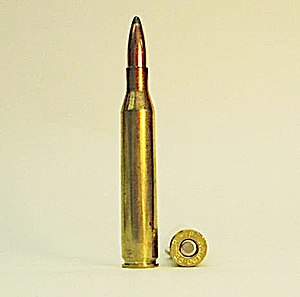This round is very popular in Texas. Where I have found that those Old Boys are very savvy about their guns. So take that for what it is worth!
I found it to be a very flat shooting, low recoil round myself.
| .25-06 Remington | ||||||||||||||||
|---|---|---|---|---|---|---|---|---|---|---|---|---|---|---|---|---|

.25-06 Remington cartridge
|
||||||||||||||||
| Type | Rifle, Hunting | |||||||||||||||
| Production history | ||||||||||||||||
| Designer | Remington Arms Company | |||||||||||||||
| Designed | 1969 | |||||||||||||||
| Manufacturer | Remington | |||||||||||||||
| Produced | 1969-Present | |||||||||||||||
| Specifications | ||||||||||||||||
| Parent case | .30-06 [1] | |||||||||||||||
| Bullet diameter | .257 in (6.5 mm) | |||||||||||||||
| Neck diameter | .290 in (7.4 mm) | |||||||||||||||
| Shoulder diameter | .441 in (11.2 mm) | |||||||||||||||
| Base diameter | .470 in (11.9 mm) | |||||||||||||||
| Rim diameter | .473 in (12.0 mm) | |||||||||||||||
| Rim thickness | .05 in (1.3 mm) | |||||||||||||||
| Case length | 2.494 in (63.3 mm) | |||||||||||||||
| Overall length | 3.250 in (82.6 mm) | |||||||||||||||
| Case capacity | 65.8 gr H2O (4.26 cm3) | |||||||||||||||
| Rifling twist | 1 in 10 in (250 mm) | |||||||||||||||
| Primer type | Large rifle | |||||||||||||||
| Maximum pressure | 63,000 psi (430 MPa) | |||||||||||||||
| Ballistic performance | ||||||||||||||||
|
||||||||||||||||
| Test barrel length: 24″ Source(s): Remington Arms [2] |
||||||||||||||||
The .25-06 Remington had been a wildcat cartridge for half a century before being standardized by Remington in 1969. It is based on the .30-06 Springfield cartridge necked-down (case opening made narrower) to .257 caliber with no other changes. Nominal bullet diameter is 0.257 inches (6.53 mm) and bullet weights range from 75 to 120 grains (4.9 to 7.8 g).
Contents
[hide]
History[edit]
Charles Newton necked down the .30-06 Springfield cartridge in 1912 to accept the 117-grain .25-35 Winchester bullet.[3] Newton’s early modification encouraged commercial release of a shortened case (from 63 to 49mm) as the .250-3000 Savagein 1915.[4] Frankford Arsenal developed an experimental .25-06 during World War I; and distribution of surplus United States military equipment through the Civilian Marksmanship Program following the war encouraged independent gunsmiths to experiment with the cartridge.[3] A. O. Niedner of Dowagiac, Michigan introduced rifles for the .25 Niedner in 1920.[5] Niedner Arms Corporation retained the 17° 30′ .30-06 shoulder chambering .25 caliber barrels rifled with one twist in 12 inches (300 mm).[6]Similar cartridges were identified as the .25 Hi-Power, .25 Whelen (analogous to .35 Whelen), or .25-100-3000 (to indicate the ability to achieve 3000 feet per second with a 100 grain bullet rather than the 87 grain bullet used in the .250-3000 Savage). Greater case capacity offered minimal velocity improvement over the .250-3000 Savage case with contemporary smokeless powders.[7] Availability of DuPont‘s Improved Military Rifle (IMR) powders encouraged commercial release of the .257 Roberts using the 57mm-long Mauser case in 1934.[8] Release of IMR 4350 in 1940 and availability of surplus 4831 powder salvaged from Oerlikon 20mm cannoncartridges after World War II greatly improved performance of the full-length .25-06 case.[9]
Performance[edit]
The cartridge is capable of propelling a 117 grain (7.6 g) bullet at up to 3,200 feet per second (980 m/s) and energy levels up to 2,500 ft⋅lbf (3,400 J). Bullets lighter than 75 grains are available in .257 caliber, but were designed for the smaller .25-20 Winchester and .25-35 Winchester cartridges and are too lightly constructed for the high velocities of the .25-06.
The cartridge has less felt recoil than a 30-06 in a similar weight rifle, due to the lighter weight bullets used. Shooters who are recoil sensitive will find the recoil from the 25-06 bearable, but not pleasant enough to shoot all day long. This cartridge is not quite as powerful as the .257 Weatherby Magnum, usually running 200–300 ft/s (61–91 m/s). slower with a given bullet weight.
SAAMI pressure limit for the .25-06 is 63,000 PSI.
Uses[edit]

Left: .17 HMR, center and right: .25-06 Remington
.25-caliber bullets typically have high ballistic coefficients without being heavy. This characteristic, when combined with the large case capacity of its parent .30-06 case, allows relatively high muzzle velocities without heavy recoil. The combination of high ballistic coefficients with high muzzle velocities give the .25-06 a very flat trajectory as well as retaining kinetic energy down-range.
The .25-06 is generally considered to be a good round for medium-sized game such as deer and antelope because of its combination of substantial kinetic energy and moderate recoil. The addition of a flat trajectory makes it particularly popular in plains states where the open fields can require longer-range shots on game, as this flatness tends to minimize range-estimation errors by the hunter. However bullet types and weights are loaded that allow the .25-06 to be used for taking game ranging from small animals like prairie dogs and coyotes to heavier elk. These bullets range from lightly constructed 75-grain bullets with muzzle velocities in the 3,700 ft/s (1,130 m/s) range to more robust 120-grain bullets with muzzle velocities in the 3,000 ft/s (915 m/s) range.
Most manufacturers of bolt action or single-shot rifles offer the .25-06 as a standard chambering and factory loaded ammunition is available from Remington, Winchester, Federal Cartridge and most other major manufacturers.